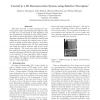Free Online Productivity Tools
i2Speak
i2Symbol
i2OCR
iTex2Img
iWeb2Print
iWeb2Shot
i2Type
iPdf2Split
iPdf2Merge
i2Bopomofo
i2Arabic
i2Style
i2Image
i2PDF
iLatex2Rtf
Sci2ools
ICCV
1999
IEEE
1999
IEEE
Control in a 3D Reconstruction System using Selective Perception
This paper presents a control structure for general purpose image understanding that addresses both the high level of uncertainty in local hypotheses and the computational complexity of image interpretation. The control of vision algorithms is performed by an independent subsystem that uses Bayesian networks and utility theory to compute the marginal value of information provided by alternative operators and selects the ones with the highest value. We have implemented and tested this control structure with several aerial image datasets. The results show that the knowledge base used by the system can be acquired using standard learning techniques and that the value-driven approach to the selection of vision algorithms leads to performance gains. Moreover, the modular system architecture simpli es the addition of both control knowledge and new vision algorithms.
Aerial Image Datasets | Computer Vision | Control Knowledge | Control Structure | General Purpose Image | ICCV 1999 | Vision Algorithms |
Related Content
| Added | 15 Oct 2009 |
| Updated | 15 Oct 2009 |
| Type | Conference |
| Year | 1999 |
| Where | ICCV |
| Authors | Maurício Marengoni, Allen R. Hanson, Shlomo Zilberstein, Edward M. Riseman |
Comments (0)

